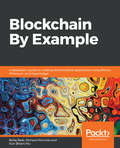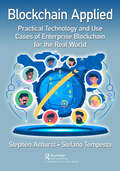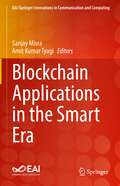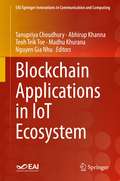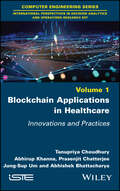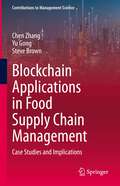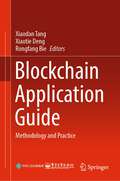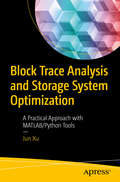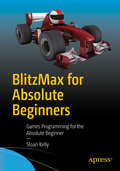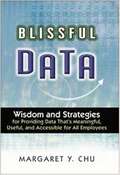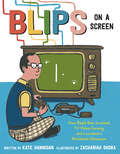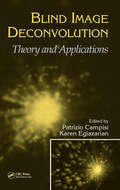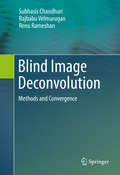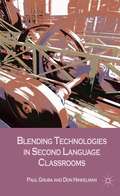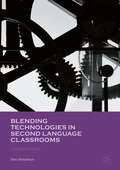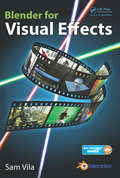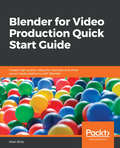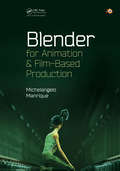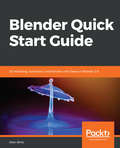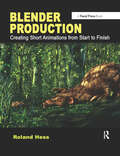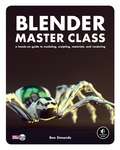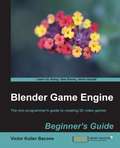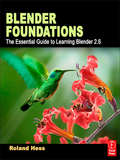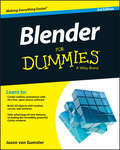- Table View
- List View
Blockchain By Example: A developer's guide to creating decentralized applications using Bitcoin, Ethereum, and Hyperledger
by Bellaj BadrIf you are keen on learning how to build blockchain decentralized applications from scratch, then this book is what you need. It explains all the basic concepts required to develop your own intermediate projects.
Blockchain Applied: Practical Technology and Use Cases of Enterprise Blockchain for the Real World
by Stephen Ashurst Stefano TempestaBlockchain is an emerging technology for organizations to almost instantaneously make and verify transactions, streamlining business processes, saving money, and reducing the potential for fraud. This book covers the application of blockchain technology to the enterprise world, it describes the opportunities and challenges for adoption of DLT (Digital Ledger Technology) in a corporate environment, and specific use cases that may benefit from a decentralized and distributed trustless network. There are many books on blockchain, the new de-centralised ledger technology made famous (or infamous) by Bitcoin, Onecoin and others. But as cryptocurrencies and stock markets rise and fall with surprise volatility and the world economy emerges changed by coronavirus and the resulting economic crash, many in industry are looking again at the powerful features of blockchain and how these may help them adapt. This new book sets out the core features of blockchain and uniquely describes, in natural language and in real-life scenarios, how de-centralised ledgers may affect industries as varied as virus-tracking apps, finance, investment and healthcare.
Blockchain Applications in the Smart Era (EAI/Springer Innovations in Communication and Computing)
by Sanjay Misra Amit Kumar TyagiThis book covers a variety of topics and trends related to blockchain technology for smart era applications. The applications span industries such as health, government, energy management, manufacturing, finance, information systems, all far beyond blockchain's original use in cryptocurrency. The authors present variants, new models, practical solutions, and technological advances related to blockchain in these fields and more. The applications within these fields include blockchain and cyber-security, IoT security and privacy using blockchain, and blockchain in industries and society . A variety of case studies are also included. The book is applicable to researchers, professionals, students, and professors in a variety of fields in communications engineering.
Blockchain Applications in IoT Ecosystem (EAI/Springer Innovations in Communication and Computing)
by Nguyen Gia Nhu Tanupriya Choudhury Abhirup Khanna Teoh Teik Toe Madhu KhuranaThis book focuses on the fundamentals of blockchain technology along with the means and methods of its integration with Internet of Things (IoT). The book allows the reader to have a deeper understanding of blockchain technology, IoT and various application areas wherein both technologies can be implemented. The book serves the purpose of providing knowledge about the fundamentals of blockchain and IoT to a common reader along with allowing a research scholar to identify some futuristic problem areas that emerge from the convergence of both technologies. Furthermore, the authors discuss relevant application areas such as smart city, e-healthcare, smart travel, etc. throughout the course of the book. The book also talks through a few case studies illustrating the implementation and benefits of using blockchain and IoT. Provides a comprehensive view of blockchain technology and its integration with IoT;Facilitates in having a valuable understanding of various application areas pertaining to blockchain and IoT;Assists the reader in exploring new research areas wherein blockchain and IoT can find their applicability based upon their list of benefits.
Blockchain Applications in Healthcare: Innovations and Practices
by Tanupriya ChoudhuryBlockchain is new-age technology used to track every transaction using cryptocurrency across servers linked in a peer-to-peer network, enabling transactions to be secure, transparent and reliable. Retaining an efficient, secure and patient-centric healthcare industry has never been so important, especially due to the damaging effects of the Covid-19 pandemic. The applicability of Blockchain in the healthcare domain can be seen as a remarkable opportunity for researchers and scientists to solve real-world problems. This book focuses on the fundamentals of Blockchain technology along with the methods of its integration with the healthcare industry. It also provides an enhanced understanding of Blockchain technology, AI and IoT across the various application areas of the healthcare industry. Furthermore, throughout the book, areas of relevant applications, such as patient data privacy protection, pharmaceutical supply chains and genomics are discussed.
Blockchain Applications in Food Supply Chain Management: Case Studies and Implications (Contributions to Management Science)
by Steve Brown Chen Zhang Yu GongThis book contributes to blockchain applications in food supply chain management from both theoretical and practical perspectives. By using the case study research method, it empirically investigates why and how food companies implement blockchain technology. Moreover, it proposes a conceptual framework based on the case findings and extant literature. The book provides empirical evidence to verify academic findings such as critical success factors and barriers. Furthermore, it identifies the implementation process to answer the ‘how’ question. Uniquely, it applies the innovation process model and the practice-based view (PBV) to studies on food supply chains and blockchain. Thus, building on the original model and theory, it enriches the theory on blockchain implementation, making it a valuable asset for all researchers and practitioners interested in blockchain adoption and food supply chain management.
Blockchain Application Guide: Methodology and Practice
by Xiaotie Deng Xiaodan Tang Rongfang BieThis book focuses on progress, concerns and approaches of blockchain application. It summarizes basic concepts, principles and standardization of blockchain technology, as well as the status of blockchain application and industry. It provides an ecology model and an evaluation method for blockchain applications and analyses the governance of blockchain applications. It presents application values and practices in financial services, logistics, government service, culture and education, and people’s livelihood and includes analysis of scenarios and use cases. This book is a summary of the experience of more than 20 experts from enterprises and institutions active in the blockchain industry. It provides a panorama of blockchain applications for users, technology and service providers, application developers and operators and supervisors.
Block Trace Analysis and Storage System Optimization: A Practical Approach with MATLAB/Python Tools
by Jun XuUnderstand the fundamental factors of data storage system performance and master an essential analytical skill using block trace via applications such as MATLAB and Python tools. You will increase your productivity and learn the best techniques for doing specific tasks (such as analyzing the IO pattern in a quantitative way, identifying the storage system bottleneck, and designing the cache policy).In the new era of IoT, big data, and cloud systems, better performance and higher density of storage systems has become crucial. To increase data storage density, new techniques have evolved and hybrid and parallel access techniques—together with specially designed IO scheduling and data migration algorithms—are being deployed to develop high-performance data storage solutions. Among the various storage system performance analysis techniques, IO event trace analysis (block-level trace analysis particularly) is one of the most common approaches for system optimization and design. However, the task of completing a systematic survey is challenging and very few works on this topic exist. Block Trace Analysis and Storage System Optimization brings together theoretical analysis (such as IO qualitative properties and quantitative metrics) and practical tools (such as trace parsing, analysis, and results reporting perspectives). The book provides content on block-level trace analysis techniques, and includes case studies to illustrate how these techniques and tools can be applied in real applications (such as SSHD, RAID, Hadoop, and Ceph systems). What You’ll Learn Understand the fundamental factors of data storage system performanceMaster an essential analytical skill using block trace via various applicationsDistinguish how the IO pattern differs in the block level from the file levelKnow how the sequential HDFS request becomes “fragmented” in final storage devicesPerform trace analysis tasks with a tool based on the MATLAB and Python platformsWho This Book Is For IT professionals interested in storage system performance optimization: network administrators, data storage managers, data storage engineers, storage network engineers, systems engineers
BlitzMax for Absolute Beginners: Games Programming for the Absolute Beginner
by Sloan KellyGo through the steps necessary to create high-speed 2D retro-style games. This easy-to-read-and-follow one of a kind book on BlitzMax game programming also covers some 3D programming. BlitzMax for Absolute Beginners includes game application projects such as The Great Escape, Tank Attack, and Paratrooper. These will help you build your skills as you go. Have you ever wanted to program your own computer game? Never felt you could? Well, now you can. What You'll Learn Program computer games from scratch with BlitzMax Produce high-quality arcade games with sound and graphics Utilize the power of OpenGL to create fantastic 3D effects Who This Book Is For Those new to game programming and those new to BlitzMax.
Blissful Data: Wisdom And Strategies For Providing Meaningful, Useful, And Accessible Data For All Employees
by Margaret Y. ChuAnalyzing information and acting accordingly is a key strategic goal of every business. But vast quantities of data are of little use if they are not structured and kept in such a way as to be readily accessible and applicable. Only optimally organized information can drive maximum productivity. Blissful Data is a reader-friendly book that reveals what it takes to achieve a state of perfect organization within the environment of a successful data warehouse. This timely book will help the reader: * understand how data evolves into information that drives better decision making * recognize the pitfalls, caused by people and politics, that lead to short-sighted solutions and long-term problems * manage data warehousing costs, performance, and expectations effectively * apply project management fundamentals to data warehouse endeavors. Blissful Data includes dozens of examples, as well as case studies illustrating successful, unsuccessful, and disastrous data warehouse strategies.
Blips on a Screen: How Ralph Baer Invented TV Video Gaming and Launched a Worldwide Obsession
by Kate HanniganAn engaging picture book biography based on the incredible true story of a Jewish refugee who pioneered home video games and launched a worldwide obsession.Do you ever wonder how video gaming was invented? What came before your PlayStation or Xbox? This is the story of Ralph Baer, a refugee from Nazi Germany, who used his skills--and a lot of ingenuity and persistence--to make life a little more fun. Television was new when Ralph returned from serving in World War II, but he didn't settle for watching TV. He knew it could be even more fun if you could play with it. He tinkered and tested, got help and rejected, but with perseverance and skill, he made his vision come true! This is the inspiring story of a fearless inventor who made TV video games a reality.
Blind Image Deconvolution: Theory and Applications
by Patrizio Campisi Karen EgiazarianBlind image deconvolution is constantly receiving increasing attention from the academic as well the industrial world due to both its theoretical and practical implications. The field of blind image deconvolution has several applications in different areas such as image restoration, microscopy, medical imaging, biological imaging, remote sensing, astronomy, nondestructive testing, geophysical prospecting, and many others. Blind Image Deconvolution: Theory and Applications surveys the current state of research and practice as presented by the most recognized experts in the field, thus filling a gap in the available literature on blind image deconvolution.Explore the gamut of blind image deconvolution approaches and algorithms that currently exist and follow the current research trends into the future. This comprehensive treatise discusses Bayesian techniques, single- and multi-channel methods, adaptive and multi-frame techniques, and a host of applications to multimedia processing, astronomy, remote sensing imagery, and medical and biological imaging at the whole-body, small-part, and cellular levels. Everything you need to step into this dynamic field is at your fingertips in this unique, self-contained masterwork.For image enhancement and restoration without a priori information, turn to Blind Image Deconvolution: Theory and Applications for the knowledge and techniques you need to tackle real-world problems.
Blind Image Deconvolution: Methods and Convergence
by Subhasis Chaudhuri Rajbabu Velmurugan Renu RameshanBlind deconvolution is a classical image processing problem which has been investigated by a large number of researchers over the last four decades. The purpose of this monograph is not to propose yet another method for blind image restoration. Rather the basic issue of deconvolvability has been explored from a theoretical view point. Some authors claim very good results while quite a few claim that blind restoration does not work. The authors clearly detail when such methods are expected to work and when they will not. In order to avoid the assumptions needed for convergence analysis in the Fourier domain, the authors use a general method of convergence analysis used for alternate minimization based on three point and four point properties of the points in the image space. The authors prove that all points in the image space satisfy the three point property and also derive the conditions under which four point property is satisfied. This provides the conditions under which alternate minimization for blind deconvolution converges with a quadratic prior. Since the convergence properties depend on the chosen priors, one should design priors that avoid trivial solutions. Hence, a sparsity based solution is also provided for blind deconvolution, by using image priors having a cost that increases with the amount of blur, which is another way to prevent trivial solutions in joint estimation. This book will be a highly useful resource to the researchers and academicians in the specific area of blind deconvolution.
Blending Technologies in Second Language Classrooms
by Paul Gruba Don HinkelmanThis book introduces an approach for making principled decisions about the use of technologies specifically in Applied Linguistics. The research is grounded in the growing area of 'blended learning' that seeks to combine face-to-face instruction with online-based interactions. With both novice and experienced instructors in mind, Gruba and Hinkelman explain how to make decisions regarding computers in settings that are primarily taught face to face. Written in an accessible manner, and drawing on research and examples from a variety of contexts to illustrate and justify blended learning concepts, this new paperback will be a useful resource for language teachers, TESOL teachers and teacher educators.
Blending Technologies in Second Language Classrooms
by Don HinkelmanThis book introduces an approach for making principled decisions about the use of technologies specifically in Applied Linguistics. The research is grounded in the growing area of 'blended learning' that seeks to combine face-to-face instruction with online-based interactions to record students using a foreign language productively.
Blender for Visual Effects
by Sam VilaBringing concrete examples from industry to light, this book explains how to use Blender to create visual effects for video/film production. It supplies readers with a practical way to learn how to use Blender's tools across a wide range of scenarios in video/film production, including setting up cameras on a stage, lighting, and other production p
Blender for Video Production Quick Start Guide: Create high quality videos for YouTube and other social media platforms with Blender
by Allan BritoUse Blender to edit and produce video for YouTube or any other social media platformsKey FeaturesUse the Blender Video editing toolkit and UIMake 3D info-graphics and interactive video with the latest Blender toolkitPrepare a video production with live markings for trackingBook DescriptionOne of the critical components of any workflow related to video production is a reliable tool to create and edit media such as video and audio. In most cases, you will find video producers using software that can only cut and mount video in a "traditional" way. What if you could use a software that offers not only options to edit and cut video, but also create 3D content and animation? With Blender, you can make use of a fantastic set of tools to edit and cut video, and also produce 3D content that will enable you to take your productions to the next level.Do you want to take footage from a camera and cut or add sound and titles? This book will show you how Blender can do that for you! You will learn to add 3D virtual objects to the same footage that will help you to create a full 3D environment. Using some camera tricks, you can even turn Blender into a powerful 2.5D animation software to create compelling infographics to produce educational, marketing, and instructional videos. You will also learn how to work with motion tracking to mix live-action footage with virtual objects. You will then learn how to use the video editing capabilities of Blender and match 3D content to your project for YouTube or any other media.Toward the end of the book, you will export the project to YouTube using optimal settings for the best performance in the platform.What you will learnImport video and audio footage to BlenderUse the Video Sequencer Editor to manipulate footagePrepare a project related to video in BlenderCut and reorganize video footage in BlenderCreate animations and add voiceover and sound to videoBuild infographics based on 3D contentBlend 3D content with live-action footageExport video for YouTube using optimal settingsWho this book is forAnyone trying to produce content based on video for platforms like YouTube. Those artists will need a software to cut and edit video footage or make small intro clips, animations, or info graphics for video.
Blender for Animation and Film-Based Production
by Michelangelo ManriqueSee Why Blender Is Right for Your Studio's PipelineBlender for Animation and Film-Based Production explores why Blender is ideal for animation films. It demonstrates Blender's capability to do the job in each production department. Whether you are a beginner or more advanced user, you'll see why Blender should be taken into consideration in animati
Blender Scripting with Python: Automate Tasks, Write Helper Tools, and Procedurally Generate Models in Blender 4
by Isabel LupianiLearn to automate tasks, develop custom extensions, and procedurally generate meshes in Blender. This book will show you how to streamline virtually every stage of the 3D modeling pipeline for your next game or animation project. Start with a hands-on introduction to the Blender Python API and dive right into basics like loading/running scripts and turning hand-modelling steps into Python by capturing them in the Info Editor. Then experiment with Blender menu options, typing them into the Python console and watch things move in the viewport. You’ll also dissect with Blender-shipped add-ons and take advantage of built-in templates to quickly create new scripts. With a firm grasp of scripting basics, you'll start to develop your own add-ons for editing and generating models. Then add more advanced mesh edits like extrude and loop cut-and-slides to your script, and essentials for shaping mesh elements like merge, bevel, and so on. Putting it altogether, you’ll create an extension to procedurally generate stylized fire hydrants with parametric controls. In addition to mesh editing, you’ll learn to develop production-quality extensions covering various stages of a 3D pipeline, such as retopology, UV mapping, texture painting, and more. Discover along the way how to implement just about any input widgets for your extension. Then package, distribute, and market your extensions through different channels, and produce impressive time-lapsed demos to showcase your procedural content generation (PCG) algorithms. Whether you are new to the Blender Python API or looking to take your add-ons to the next level, this book will support you in your journey in generating 3D content and automating your Blender workflow. What You Will Learn ● Develop add-ons for automating various stages of a 3D modeling pipeline ● Edit meshes with the Blender Python API and procedurally generate models. ● Master use of parametric controls in add-ons for mesh editing or procedural generation to govern the ranges and types of variation produced ● Develop extensions complete with UI using various input methods, including drawing on meshes with the Grease Pencil. ● Make time-lapsed and interactive demos of your procedural content generation algorithms. ● Package, distribute, and market your Blender extensions through different channels. Who This Book Is For New and seasoned users of the Blender Python API, that have either some experience with Blender or some experience with general Python development.
Blender Quick Start Guide: 3D Modeling, Animation, and Render with Eevee in Blender 2.8
by Allan BritoLearn the new Blender 2.8 user interface and make 3D modelsKey FeaturesFind your way round the new user interface and tools of Blender 2.8Create materials, apply textures and render scenesUse the new cutting-edge real-time render EEVEE in your projectsBook DescriptionBlender is open source 3D creation software. With a long history and an enthusiastic community of users, it is the ideal choice for almost any kind of work with 3D modeling or animation. However, for new users, its power and flexibillity can sometimes be daunting, and that’s when you need this book!The book starts by showing you round the all-new Blender 2.8 user interface. You'll look at the most commonly-used options and tools, such as navigating in 3D and selecting objects. You will then use and manipulate one of the most important windows of the interface, the 3D View.You'll learn how to use essential tools for working with 3D modeling. To give your models the feel of real-world objects, you'll learn how to create materials and set up surfaces. You'll see how to use Physically-Based Rendering (PBR), which allows you to craft realistic surfaces such as wood, stone, and metal. You will also work with Eevee, a new real-time render engine in Blender. You will see how to add motion to objects, making use of Blender's impressive 3D animation features. Finally, you'll learn how to create scenes and organize them for rendering, and later add titles and effects using built-in Blender tools.By the end of the book, you will be able to use Blender 2.8 new UI, Create 3D Models with textures, Animations, and Render them in real-time using Eevee.What you will learnManipulate and visualize your 3D objects in BlenderUse polygon modeling tools such as extrude, loop cut, and moreApply precision modeling tools like snapping and the 3D CursorRender a scene using the real-time engine EeveeCreate materials for Eevee and CyclesRender a scene with the Eevee real-time engineUse PBR textures to craft realistic surfaces such as wood with the Shader EditorAdd motion and animation using keyframesCreate animation loops using curves and modifiersWho this book is forThis book is for anyone interested in taking their steps with Blender. If you're an experienced 3D artists or hobbyist, this book will help you with its features.
Blender Production: Creating Short Animations from Start to Finish
by Roland HessBlender has become one of the most popular 3D animation tools on the market because it is robust and absolutely free. Blender Production is the definitive resource for anyone who wants to create short animations from scratch. With this book, and Blender, you have the ideal platform to make it happen. Blender expert and author Roland Hess walks you through the entire process of creating a short animation including: writing, storyboarding, blocking, character creation, animation, rendering, and production. The associated web site includes the full Blender software kit and a complete short animation work broken down into handy modules that animators can study, learn from, and reuse in their own animated films. The sample project files amount to 100+ MB of cool content, including models, textures, materials, scenes and animation work.
Blender Master Class: A Hands-On Guide to Modeling, Sculpting, Materials, and Rendering
by Ben SimondsBlender is a powerful and free 3D graphics tool used by artists and designers worldwide. But even experienced designers can find it challenging to turn an idea into a polished piece.For those who have struggled to create professional-quality projects in Blender, author Ben Simonds offers this peek inside his studio. You’ll learn how to create 3D models as you explore the creative process that he uses to model three example projects: a muscular bat creature, a futuristic robotic spider, and ancient temple ruins. Along the way, you’ll master the Blender interface and learn how to create and refine your own models.You’ll also learn how to:–Work with reference and concept art in Blender and GIMP to make starting projects easier–Block in models with simple geometry and build up more complex forms–Use Blender’s powerful sculpting brushes to create detailed organic models–Paint textures with Blender and GIMP and map them onto your 3D artwork–Light, render, and composite your models to create striking imagesEach chapter walks you through a piece of the modeling process and offers detailed explanations of the tools and concepts used. Filled with full-color artwork and real-world tips, Blender Master Class gives you the foundation you need to create your own stunning masterpieces.DVD includes files for each project in the book, as well as extra textures, brushes, and other resources.Covers Blender 2.6x
Blender Game Engine: Beginner’s Guide
by Victor Kuller BaconeCreate a complete game step by step with no previous experience necessary. Practical tutorials take you through the entire process from beginning to end. If you have used Blender before but never got to grips with the Blender Game Engine (BGE), this book is for you. If you have tried and failed with other game development environments, or if scripting is not your strong point, this is where you should start.
Blender Foundations: The Essential Guide to Learning Blender 2.5
by Roland HessBlender Foundations is the definitive resource for getting started with 3D art in Blender, one of the most popular 3D/Animation tools on the market . With the expert insight and experience of Roland Hess, noted Blender expert and author, animators and artists will learn the basics starting with the revised 2.6 interface, modeling tools, sculpting, lighting and materials through rendering, compositing and video editing. Some of the new features covered include the completely re-thought interface, the character animation and keying system, and the smoke simulator. More than just a tutorial guide, "Blender Foundations" covers the philosophy behind this ingenious software that so many 3D artists are turning to today. Start working today with Blender with the accompanying web site which includes all of the projects and support files alongside videos, step-by-step screenshots of the trickier tutorials, as well as a direct links to official resources like the Blender download site and artist forums.
Blender For Dummies
by Jason Van GumsterSo you've heard about Blender, the free 3D animation software. You really want to know more about the features of Blender, where to get it, and how to use it. You're in luck! It's all in Blender For Dummies, including Blender software on the bonus DVD. Because there's a lot to learn about Blender, you'll be glad this book takes it step by step. First, you'll learn to install Blender 2. 48 and think the Blender way. Then you'll start creating 3D objects and setting them in motion with animations and rigging. Soon you'll be texturing with Blender, rendering with Blender, and sharing your creations. You'll learn how to: Create almost anything with meshes, save time with the Mirror modifier, and use Blender's secret weapon, Dupliverts Understand texture mapping, know when to use which type of lamp, and use radiosity in animation Work with curves and surfaces, and add color, shades, texture, and reflections Rig your characters for animation with shape keys, hooks, and armatures, and understand kinematics Navigate in three dimensions Make your animations more believable, and let Blender do the animating for you Use the video sequence editor Export, render, composite, and edit for output You'll even get tips on common problems new Blender users face and how to avoid them. Blender For Dummies will have you creating eye-popping 3D animations before you know it! Note: CD-ROM/DVD and other supplementary materials are not included as part of eBook file.
